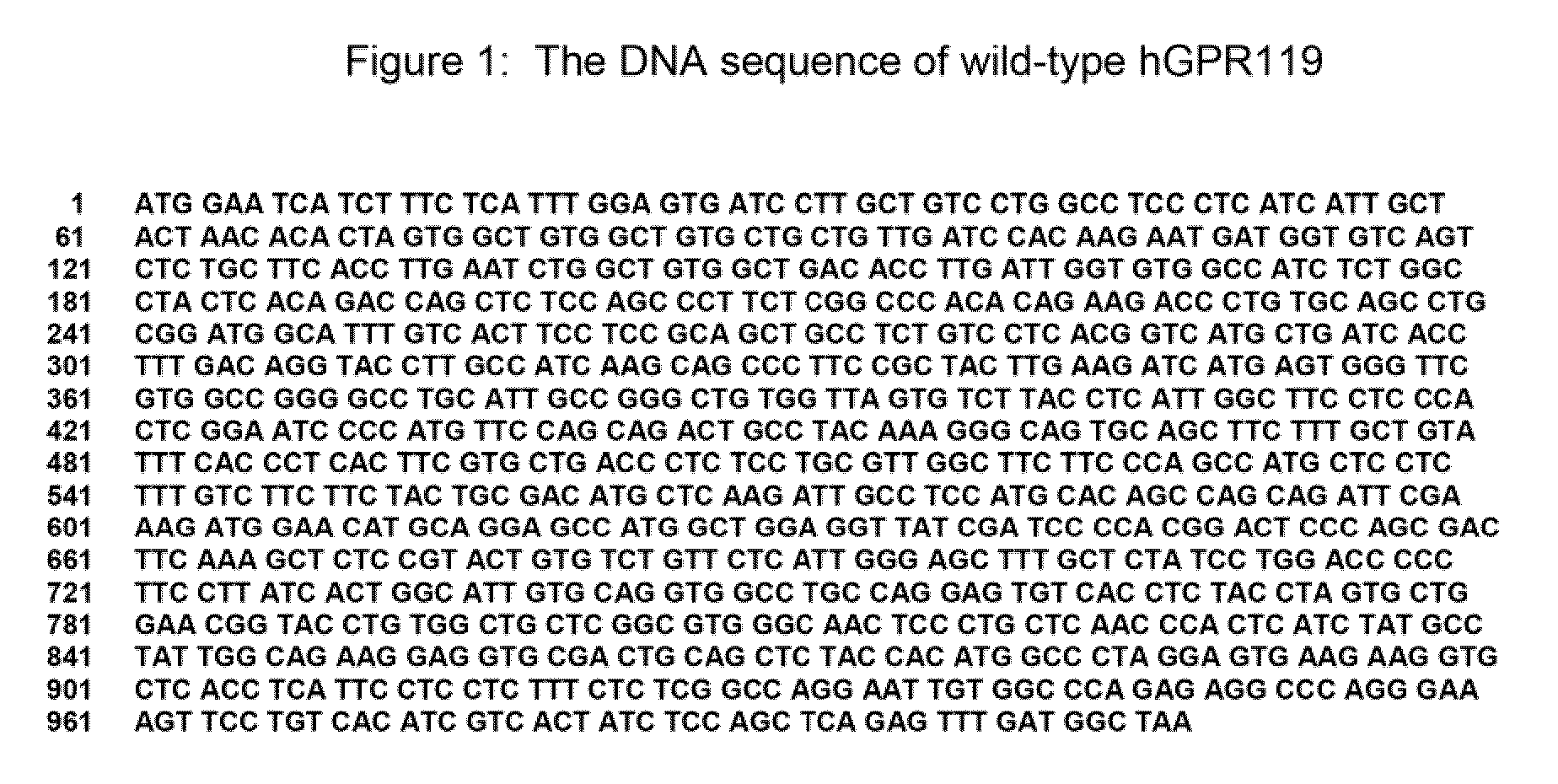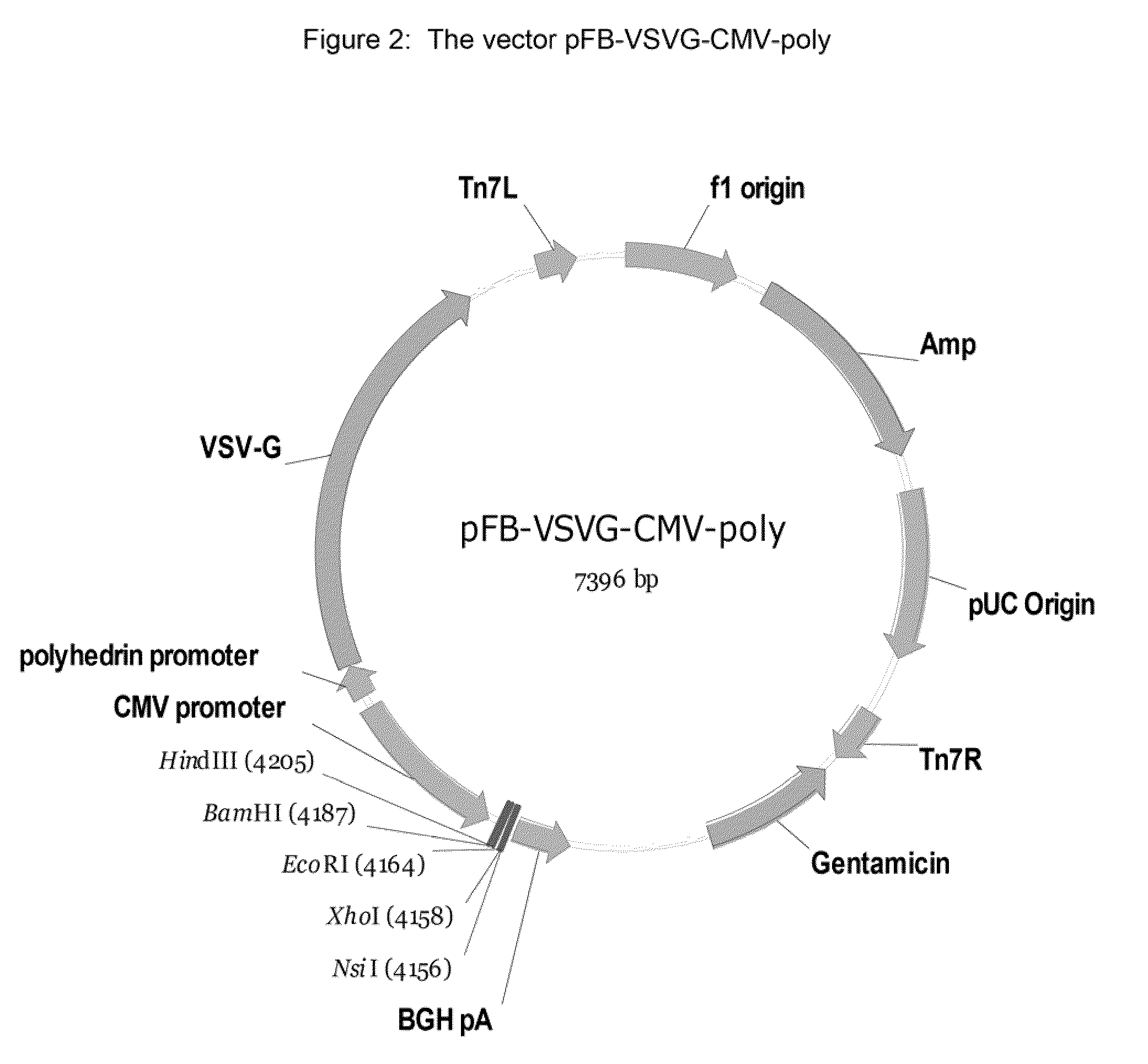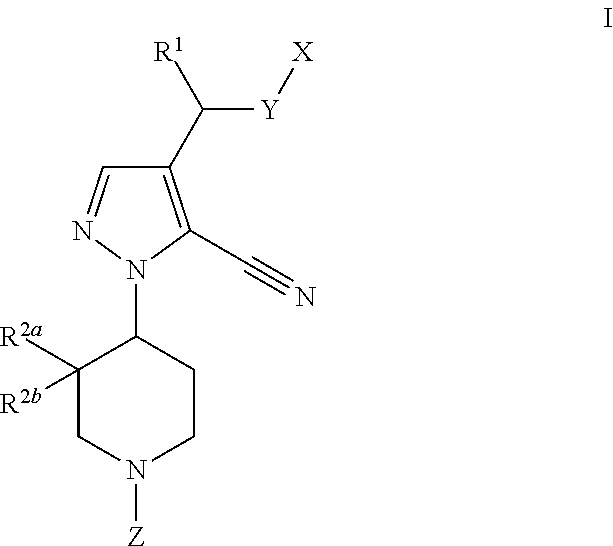GPR 119 modulators
a gpr 119 and modulator technology, applied in the field of cyanopyrazoles, can solve the problems of limited standard treatment of diabetes, no cure for diabetes, and insufficient investigation of the long-term effects of this broader effect, and achieve the effect of stimulating weight loss and modulating the activity of the gpr-coupled receptor
- Summary
- Abstract
- Description
- Claims
- Application Information
AI Technical Summary
Benefits of technology
Problems solved by technology
Method used
Image
Examples
example 1
Isopropyl 4-[5-cyano-4-({2-fluoro-4-[(2-hydroxyethyl)sulfonyl]-phenoxy}methyl)-1H-pyrazol-1-yl]piperidine-1-carboxylate
[0294]
A) Isopropyl 4-[4-({4-[(2-{[tert-butyl(dimethyl)silyl]oxy}ethyl)thio]-2-fluorophenoxy}-methyl)-5-cyano-1H-pyrazol-1-yl]piperidine-1-carboxylate
[0295]
[0296]To a solution of isopropyl 4-[5-cyano-4-(hydroxymethyl)-1H-pyrazol-1-yl]piperidine-1-carboxylate (54.4 mg, 0.19 mmol), 4-[(2-{[tert-butyl(dimethyl)silyl]oxy}ethyl)thio]-2-fluorophenol (64 mg, 0.21 mmol) and polymer-bound triphenylphosphine (3 mmol / g, 310 mg, 0.93 mmol) in 1,4-dioxane (1.7 mL) was added dropwise diethyl azodicarboxylate (0.033 mL, 0.205 mmol). The reaction mixture was stirred 16 hours under an atmosphere of nitrogen. The polymer was filtered off, and the filtrate was then evaporated under vacuum. The residue was purified by chromatography over silica gel eluting with 20% to 70% ethyl acetate in heptane to give the title compound as an oil (44 mg, 41%). 1H NMR (400 MHz, deuterochloroform) delt...
example 2
Isopropyl 4-(5-cyano-4-{[2-fluoro-4-(methylsulfonyl)phenoxy]methyl}-1H-pyrazol-1-yl)piperidine-1-carboxylate
[0298]
A) Isopropyl 4-(5-bromo-4-{[2-fluoro-4-(methylsulfonyl)phenoxy]methyl}-1H-pyrazol-1-yl)piperidine-1-carboxylate
[0299]
[0300]This compound was prepared from 2-fluoro-4-(methylsulfonyl)phenol (WO 2007054668) and isopropyl 4-[5-bromo-4-(hydroxymethyl)-1H-pyrazol-1-yl]piperidine-1-carboxylate (Preparation 4) in a manner similar to that described for the preparation of isopropyl 4-[4-({4-[(2-{[tert-butyl(dimethyl)silyl]oxy}ethyl)thio]-2-fluorophenoxy}-methyl)-5-cyano-1H-pyrazol-1-yl]piperidine-1-carboxylate (Example 1, Step A, Mitsunobu reaction). The compound was purified by chromatography on silica gel (60% ethyl acetate in hexane). 1H NMR (400 MHz, deuterochloroform) delta 7.70 (ddd, 1H), 7.67 (s, 1H), 7.65 (dd; 1H), 7.18 (t, 1H), 5.03 (s, 2H), 4.92 (m, 1H), 4.43 (m, 1H), 4.31 (br s, 2H), 3.03 (s, 3H), 2.91 (br t, 2H), 2.09 (m, 2H), 1.92 (br d, 2H), 1.25 (d, 6H).
B) Isopropy...
example 3
Isopropyl 4-(5-cyano-4-{[2-fluoro-4-(1H-tetrazol-1-yl)phenoxy]-methyl}-1H-pyrazol-1-yl)piperidine-1-carboxylate
[0302]
[0303]This compound was prepared from 2-fluoro-4-(1H-tetrazol-1-yl)phenol (Preparation 9) and isopropyl 4-[5-cyano-4-(hydroxymethyl)-1H-pyrazol-1-yl]piperidine-1-carboxylate (Preparation 5) in a manner similar to that described for the preparation of isopropyl 4-[4-({4-[(2-{[tert-butyl(dimethyl)silyl]oxy}ethyl)thio]-2-fluorophenoxy}-methyl)-5-cyano-1H-pyrazol-1-yl]piperidine-1-carboxylate (Example 1, Step A, Mitsunobu reaction). The crude product was purified by chromatography on silica gel (50% to 70% ethyl acetate in heptane). 1H NMR (400 MHz, deuterochloroform) delta 1.24 (d, J=6.3 Hz, 6H), 2.01 (br d, 2H), 2.07-2.18 (m, 2H), 2.93 (br t, 2H), 4.32 (br s, 2H), 4.46-4.56 (m, 1H), 4.91 (septet, 1H), 5.18 (s, 2H), 7.16-7.26 (m, 1H), 7.42-7.49 (m, 1H), 7.49-7.58 (m, 1H), 7.69 (s, 1H), 8.93 (s, 1H); LCMS (ES+): 455.1 (M+H).
PUM
| Property | Measurement | Unit |
|---|---|---|
| temperatures | aaaaa | aaaaa |
| temperatures | aaaaa | aaaaa |
| temperatures | aaaaa | aaaaa |
Abstract
Description
Claims
Application Information
 Login to View More
Login to View More - R&D
- Intellectual Property
- Life Sciences
- Materials
- Tech Scout
- Unparalleled Data Quality
- Higher Quality Content
- 60% Fewer Hallucinations
Browse by: Latest US Patents, China's latest patents, Technical Efficacy Thesaurus, Application Domain, Technology Topic, Popular Technical Reports.
© 2025 PatSnap. All rights reserved.Legal|Privacy policy|Modern Slavery Act Transparency Statement|Sitemap|About US| Contact US: help@patsnap.com



